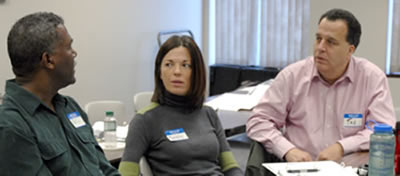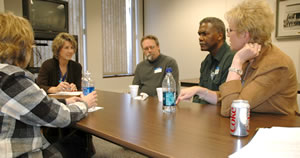|
By Craig Wilkins

Discussing workplace violence prevention strategies are (from left) Ed Clarke, Finance and Administration, and Shelly Meyer and Ted Coulianos, both with Freight and Commercial Vehicle Operations. Photo by Craig Wilkins |
Watch out—standard behavior in this work place includes shouting, swearing, trading insults and occasionally throwing tools of their trade at coworkers.
And what kind of work place might this be?
- The pit area during a NASCAR race?
- A meat packing plant?
- A hospital emergency room?
Give yourself an A if you chose the ER.
Donald Gault, director of Ramsey County’s Initiative for Violence-free Families and Communities, cites the emergency room’s dysfunction as an example of what he calls “normalized deviance” in the work place.
“At first, doctors, nurses and other staff used those behaviors to deal with intense situational stress,” he said, “but without intervention, the behavior eventually became the norm.”
Gault spoke during a violence prevention workshop for managers Oct. 17 in St. Cloud. Mn/DOT’s Violent Incident Advisory Team sponsored the event.
VIAT chair DeLorah Curry, Workforce Development, said the workshop was held to re-energize Mn/DOT’s efforts to ensure a safe, inclusive and productive workplace as well as to prevent workplace violence.
“It’s also time for district and office leaders to share what they’ve learned about managing challenging situations with their counterparts from other areas in Mn/DOT,” Curry said.
Mn/DOT staff participated in the workshop that included performances by Theater at Work.
Discussions focused on the need for Mn/DOT staff to remain alert about behavior in their workplaces in the wake of stressors such as the Interstate 35W bridge collapse, floods that ravaged southeastern Minnesota and intense public scrutiny of the department’s performance.

A group that included (from left) Sandy Danmeier, District 1; Cathy Clark, Maintenance and Security; Dale Plemmons, District 7, Ed Clarke, Finance and Administration, and Brenda Wrobel, District 8, addresses root causes of work place violence. Photo by Craig Wilkins |
Theater at Work’s presentation used professional actors to illustrate how troublesome workplace situations can suddenly arise from poor communication, unclear role assignments and losing sight of common goals.
Actors demonstrated how easily disagreements can become disruptive or violent from gossip and teasing, rumors and unclear job responsibilities, for example.
Then the actors replayed the sketch to show how early intervention can clarify and resolve the underlying issues and restore team harmony.
Participants explored those options and considered how they might use them in their places of work.
Joe Pignato, right of way program manager, Land Management and Surveys, said he was stunned by research presented and the extent of workplace violence in the United States.
Each year, participants learned, there are 16 million incidences of verbal harassment and bullying in the nation’s work places. An average of two million instances of physical contact such as shoving, pushing and hitting occur each year.
“The sketches showed how quickly verbal harassment can lead to violence,” he said. “They made it clear how we all are responsible to achieve our goal for zero tolerance in the work place.”
“This was a very helpful presentation,” said Brenda Wrobel, Willmar District administrative manager. “It showed us how easy it is to look the other way until a situation erupts. We need to use a more proactive approach and provide all district employees with tools to prevent violence and other abusive behavior.
|



